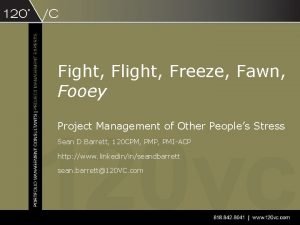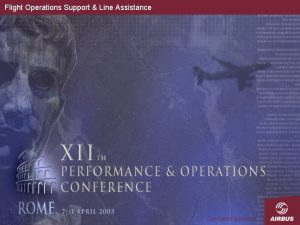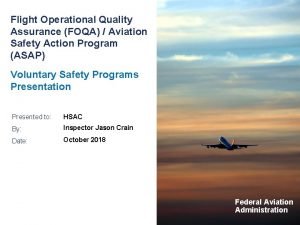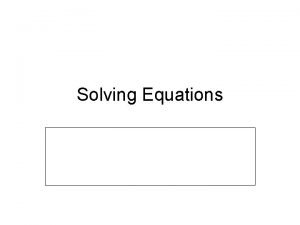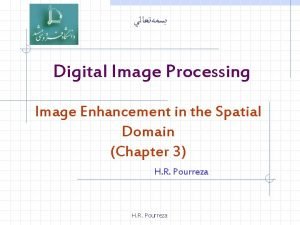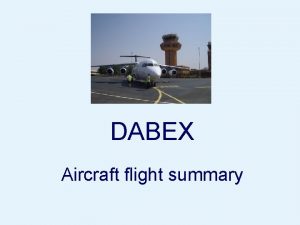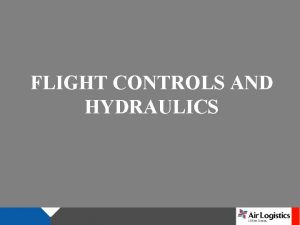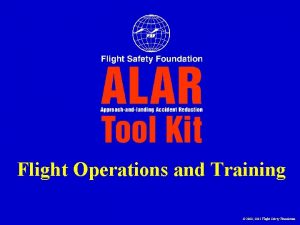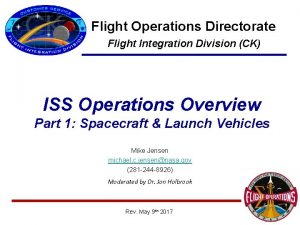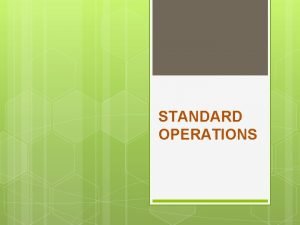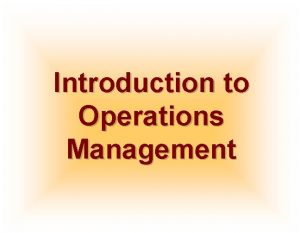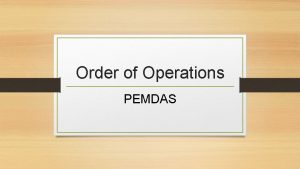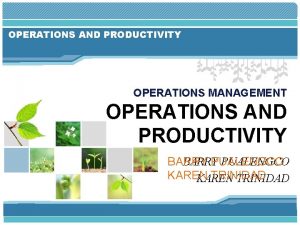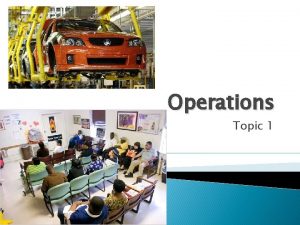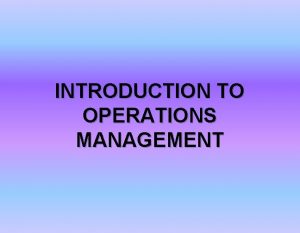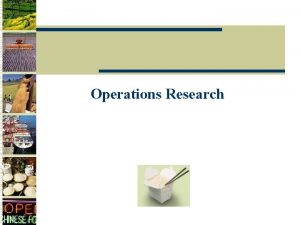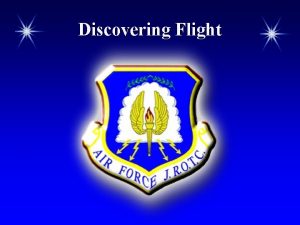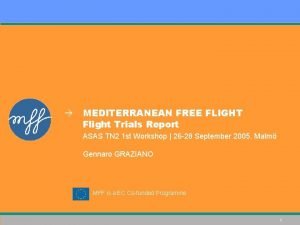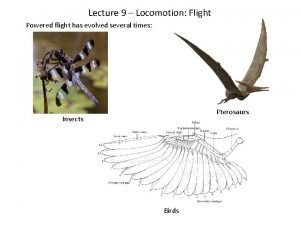Flight Operations Chapter 24 Using the Flight Computer






















- Slides: 22

Flight Operations Chapter 24 Using the Flight Computer © 2009 Aviation Supplies & Academics, Inc. All Rights Reserved. The Pilot’s Manual – Ground School

General Description The mechanical flight consists of two circular sheets of metal or card through the center of which passes a movable grid. The flight computer has two sides: • a calculator side—used for speed–distance–time–fuel computations (and many others); and • a wind side—used to calculate headings to steer and groundspeeds resulting from © 2009 Aviation Supplies & Academics, Inc. All Rights Reserved. The Pilot’s Manual – Ground School

The Calculator Side of the Flight Computer The calculator side of the flight computer consists of two circular discs riveted together at the center so that the smaller top disc can rotate over the larger bottom disc. The outer scale on the bottom disc and the inner scale on the top disc are used to represent speed, distance, fuel or other units Figure 24 -1. Calculator side of a typical flight computer. © 2009 Aviation Supplies & Academics, Inc. All Rights Reserved. The Pilot’s Manual – Ground School

The Wind Side of the Flight Computer The wind side of the flight computer calculate navigation problems involving the triangle of velocities in a quick and accurate manner. Components of the wind side are: • a circular, rotatable compass rose (or azimuth circle) set in a fixed frame which is marked with an index at the top; • a transparent plastic plotting disc attached to the rotatable compass rose, marked with a grommet in the center and • a sliding grid marked with radial lines which can be used to determine the wind correction angle (WCA). This plate slides through the frame and compass rose assembly, hence the term “slide” flight computer which is often used to refer to this type. Figure 24 -2. Wind side of the slide flight computer. © 2009 Aviation Supplies & Academics, Inc. All Rights Reserved. The Pilot’s Manual – Ground School

The Flight Computer and Flight Planning The main use of the flight computer is for flight planning. You will know: • the planned course and ground distance from the chart; • the planned indicated airspeed (IAS) and cruising altitude; and • the forecast wind and forecast temperature at cruise altitude. You will want to find (in order): • the true airspeed (TAS); • the heading required to “make good” the required course; and • the expected groundspeed, so that you can calculate the time en route and fuel requirements. © 2009 Aviation Supplies & Academics, Inc. All Rights Reserved. The Pilot’s Manual – Ground School

Finding TAS When flying en route you will fly at a certain IAS which you can read directly off the airspeed indicator. TAS is important for navigation. Although IAS is of aerodynamic importance, navigation requires a knowledge of the TAS. Provided you know your planned or actual IAS, your planned or actual pressure altitude, and the forecast or actual outside temperature, you can determine TAS quickly and easily using the flight computer. You can also find the TAS from your Pilot’s Operating Handbook for specified conditions. Figure 24 -3. Scenario A. © 2009 Aviation Supplies & Academics, Inc. All Rights Reserved. The Pilot’s Manual – Ground School

Find the TAS in scenario A (figure 24 -3). 1. Allow for variation in air density: on the calculator side of your flight computer locate the pressure altitude window for airspeed correction shown in figure 24 -5. The 5 represents 5, 000 feet pressure altitude, and the first graduation to the right of the 5 represents 6, 000 feet pressure altitude. Immediately above the pressure altitude window is the air temperature scale which extends from +50°C on the left to – 70°C on the right. Rotate the inner disc to line up 6, 500 feet against +20°C (the second long graduation to the left of the 0). Once correctly aligned do not rotate the inner disc further because you will disturb the air density correction. 2. Find TAS: locate the outer scale which represents TAS and the inner scale which represents IAS which are perfectly aligned (10 against 10, 11 against 11, and so on), the scales on your flight computer will be offset. This is because you have aligned 6, 500 feet altitude against +20°C in step 1, which has allowed for the reduced density at your cruise altitude. © 2009 Aviation Supplies & Academics, Inc. All Rights Reserved. The Pilot’s Manual – Ground School

3. Now find the 10 on the inner scale which represents 100 knots IAS. See figure 24 -5. Directly opposite the 10 on the inner scale is 11. 4 on the outside scale which is used to represent TAS. The TAS is therefore 114 knots. Answer. 114 KTAS. Figure 24 -5. Example 24 -1. © 2009 Aviation Supplies & Academics, Inc. All Rights Reserved. The Pilot’s Manual – Ground School

What is the expected TAS in scenario B (figure 24 -4)? 1. Line up – 5°C against 9, 500 feet in the pressure altitude window. See figure 24 -6. 2. Locate 14. 5 (for 145 knots) on the inner scale and read off 16. 7 on the outer scale. The TAS is therefore 167 knots. Answer. 167 KTAS. Figure 24 -6. Example 24 -2. © 2009 Aviation Supplies & Academics, Inc. All Rights Reserved. The Pilot’s Manual – Ground School

Finding Heading and Groundspeed At this stage of flight planning you already know the intended course (CRS) in °T, measured on an aeronautical chart, the wind velocity (W/ V) in °T/knots, obtained from the weather forecast and the expected true airspeed obtained by converting IAS to TAS (or from the Pilot’s Operating Handbook). You can then calculate the heading (HDG) to steer and the groundspeed (GS) that should be achieved. See figure 23 -8 (page 505). © 2009 Aviation Supplies & Academics, Inc. All Rights Reserved. The Pilot’s Manual – Ground School

Finding Heading and Groundspeed At this stage of flight planning you already know the intended course (CRS) in °T, measured on an aeronautical chart, the wind velocity (W/ V) in °T/knots, obtained from the weather forecast and the expected true airspeed obtained by converting IAS to TAS (or from the Pilot’s Operating Handbook). You can then calculate the heading (HDG) to steer and the groundspeed (GS) that should be achieved. See figure 23 -8 (page 505). Figure 24 -7. Example 24 -3. © 2009 Aviation Supplies & Academics, Inc. All Rights Reserved. The Pilot’s Manual – Ground School

Find the HDG and GS in scenario A (figure 24 -3, page 521). Place the W/V on the plotting disc (figure 24 -7). 1. Rotate the compass rose until the wind direction 160°T is under the true index. 2. Mark the start of the W/V vector 30 knots vertically above the grommet. At this stage in your training, it is a good idea to mark in the full W/V, showing the three arrowheads of the W/V vector pointing down toward the grommet. This will give you a very clear picture as the whole triangle of velocities is developed on the plotting disc. When you become familiar with the use of the computer, drawing each vector becomes unnecessary, and just one single mark, known as the wind dot or wind cross, to illustrate the extent of the wind velocity is all that is needed. © 2009 Aviation Supplies & Academics, Inc. All Rights Reserved. The Pilot’s Manual – Ground School

Place the TR/GS vector on the plotting disc. 3. The desired course is known (having been measured on the chart); groundspeed is not known. Therefore, only one aspect of the TR/GS vector is known—its direction, but not its magnitude. Rotate the compass rose until the required CRS of 300°T is under the index. © 2009 Aviation Supplies & Academics, Inc. All Rights Reserved. The Pilot’s Manual – Ground School

4. True airspeed is known, but the heading is not. In this case, only one aspect of the HDG/TAS vector is known —its magnitude. Move the slide and place the TAS 114 (found in example 24 -1) knots speed arc under the wind dot (which is the starting point of the W/V vector). Note that the end of the HDG/TAS vector is where the W/V begins. Read off the answers for HDG and GS. 5. The GS of 135 knots appears under the grommet. 6. From the drift lines, the wind correction angle is 10° to the left of the course. This means to achieve CRS 300 T, the airplane must be headed 10 into the wind and flown on a HDG of 290°T to allow for the 10° right drift. © 2009 Aviation Supplies & Academics, Inc. All Rights Reserved. The Pilot’s Manual – Ground School

6. From the drift lines, the wind correction angle is 10° to the left of the course. This means to achieve CRS 300 T, the airplane must be headed 10 into the wind and flown on a HDG of 290°T to allow for the 10° right drift. 7. Finally, to find the magnetic heading, apply the variation. If variation is 9 W, then 290°T is 299°M (variation west, magnetic best). Answer. Magnetic heading 299°M, groundspeed 135 knots. © 2009 Aviation Supplies & Academics, Inc. All Rights Reserved. The Pilot’s Manual – Ground School

Finding the Time En Route and Fuel Requirements The time en route and fuel requirements are found using the calculator side of the flight computer. to solve speed–time–distance problems and fuel calculations, which are rate problems, the inner scale represents time and the outer scale represents distance or fuel. In rate problems: Speed–Time–Distance Problems There are three basic problems. 1. How far will you travel at a given speed in a specified time? 2. How long will it take to fly a given distance at a known speed? 3. What is the groundspeed achieved knowing time and distance traveled? You can solve these problems using the equations below with your electronic calculator, or by using your flight computer, as explained in the following examples. © 2009 Aviation Supplies & Academics, Inc. All Rights Reserved. The Pilot’s Manual – Ground School

How long will the flight in scenario A (page 521) take? Rough calculation: at 135 knots groundspeed (from example 24 -3), the airplane will cover 135 GNM in 1 hour. Therefore it will take about ⅔ of an hour (40 minutes) to cover 88 GNM. 1. In 1 hour you will cover 135 NM (135 knots), therefore place 60 (to represent 60 minutes) on the inner scale, against 13. 5 (to represent 135 NM) on the outer distance scale. 2. Now find 8. 8 (88 NM) on the outer scale and read off the time it will take to cover this distance on the inner scale. See figure 24 -9. Answer. 39 minutes. © 2009 Aviation Supplies & Academics, Inc. All Rights Reserved. Figure The Pilot’s Manual – Ground School 24 -9. Example 24 -5.

Fuel Consumption Problems In scenario A (page 521), how much fuel would you expect to use during the flight? Rough calculation: at 12 gph, 12 gallons will be used in 60 minutes, therefore in 40 minutes you would use 8 gallons. Place 60 minutes opposite to 12 gallons and then read off 7. 8 gallons opposite 39 minutes. See figure 24 -11. Answer. 7. 8 gallons. Figure 24 -11. Example 24 -7. © 2009 Aviation Supplies & Academics, Inc. All Rights Reserved. The Pilot’s Manual – Ground School

© 2009 Aviation Supplies & Academics, Inc. All Rights Reserved. The Pilot’s Manual – Ground School

© 2009 Aviation Supplies & Academics, Inc. All Rights Reserved. The Pilot’s Manual – Ground School

© 2009 Aviation Supplies & Academics, Inc. All Rights Reserved. The Pilot’s Manual – Ground School

22. On a cross-country flight, point A is crossed at 1500 hours and the plan is to reach point B at 1530 hours. Use the following information to determine the indicated airspeed required to reach point B on schedule. • Distance between A and B: 70 NM • Forecast wind: 310 at 15 kts • Pressure altitude: 8, 000 ft • Ambient temperature: -10 C • True course: 270 The required indicated airspeed would be approximately: A. 126 knots. B. 137 knots. C. 152 knots. © 2009 Aviation Supplies & Academics, Inc. All Rights Reserved. The Pilot’s Manual – Ground School
 Iraad definition project management
Iraad definition project management Flight operations support
Flight operations support What is the flight operational quality assurance
What is the flight operational quality assurance Solve equations using inverse operations
Solve equations using inverse operations Combining spatial enhancement methods
Combining spatial enhancement methods Hát kết hợp bộ gõ cơ thể
Hát kết hợp bộ gõ cơ thể Frameset trong html5
Frameset trong html5 Bổ thể
Bổ thể Tỉ lệ cơ thể trẻ em
Tỉ lệ cơ thể trẻ em Gấu đi như thế nào
Gấu đi như thế nào Tư thế worm breton
Tư thế worm breton Alleluia hat len nguoi oi
Alleluia hat len nguoi oi Môn thể thao bắt đầu bằng từ chạy
Môn thể thao bắt đầu bằng từ chạy Thế nào là hệ số cao nhất
Thế nào là hệ số cao nhất Các châu lục và đại dương trên thế giới
Các châu lục và đại dương trên thế giới Công của trọng lực
Công của trọng lực Trời xanh đây là của chúng ta thể thơ
Trời xanh đây là của chúng ta thể thơ Cách giải mật thư tọa độ
Cách giải mật thư tọa độ Phép trừ bù
Phép trừ bù Phản ứng thế ankan
Phản ứng thế ankan Các châu lục và đại dương trên thế giới
Các châu lục và đại dương trên thế giới Thơ thất ngôn tứ tuyệt đường luật
Thơ thất ngôn tứ tuyệt đường luật Quá trình desamine hóa có thể tạo ra
Quá trình desamine hóa có thể tạo ra
